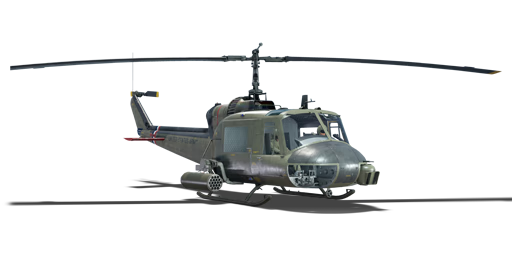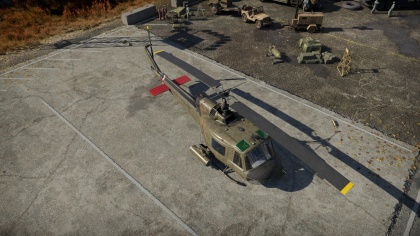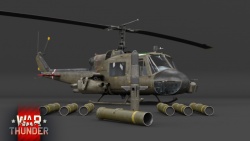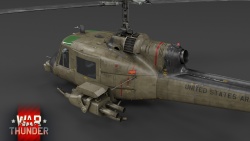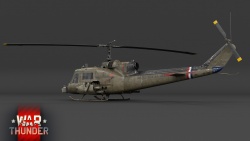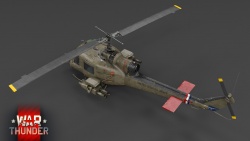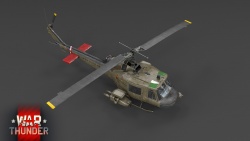Difference between revisions of "UH-1C"
(→Media: Added Shooting Range episode) |
|||
| Line 130: | Line 130: | ||
== Media == | == Media == | ||
| − | <!-- | + | <!--Excellent additions to the article would be video guides, screenshots from the game, and photos.--> |
;Images | ;Images | ||
<div><ul> | <div><ul> | ||
| Line 141: | Line 141: | ||
<li style="display: inline-block;"> [[File:UH-1C WTWallpaper 007.jpg |thumb|none|250px|]] </li> | <li style="display: inline-block;"> [[File:UH-1C WTWallpaper 007.jpg |thumb|none|250px|]] </li> | ||
</ul></div> | </ul></div> | ||
| + | |||
| + | ;Videos | ||
| + | {{Youtube-gallery|6QZAY1EtkFU|'''The Shooting Range #110''' - ''Pages of History'' section at 01:01 discusses the UH-1 Huey.}} | ||
== See also == | == See also == | ||
Revision as of 19:57, 27 March 2020
Contents
| This page is about the American utility helicopter UH-1C. For other uses, see UH-1 (Family). |
Description
The UH-1C is a rank American utility helicopter
with a battle rating of (AB), (RB), and (SB). This helicopter was introduced in Update 1.81 "The Valkyries".
General info
Flight Performance
Describe how the aircraft behaves in the air. Maximum speed, manoeuvrability, speed and allowable loads - these are the most important characteristics of the vehicle.
| Characteristics | |||
|---|---|---|---|
| Stock | |||
| Max Speed (km/h at ?,000 m) |
Max altitude (meters) | ||
| AB | RB | ||
| ? | ? | ||
| Upgraded | |||
| Max Speed (km/h at ?,000 m) |
Max altitude (meters) | ||
| AB | RB | ||
| ? | ? | ||
Survivability and armour
Examine the survivability of the helicopter. Note how vulnerable the structure is and how secure the pilot is, how many engines the vehicle has. Describe the armour, if there is any, also mention the vulnerability of other critical aircraft systems.
Armaments
Offensive armament
The UH-1C can be outfitted with the following ordnance after unlocking the tier II Weaponry module M129:
- 1 x M129 40 mm Grenade Launcher (150 RPG)
The UH-1C can be outfitted with the nose turreted M129 Grenade Launcher after researching and purchasing the tier II Weaponry module M129. The M129 is a grenade launcher which can fire 40 mm grenade shells at the rate of 400 rounds per minute with a muzzle velocity of 850 ft/s (260 m/s). An upgrade from the old M75 and redesigned, the torque produced from firing the weapon was eliminated and recoil was greatly reduced. To ensure safe operation of the M129, when the trigger finger releases the firing trigger, the launcher automatically recenters itself and points forward (safe position) before firing can be resumed.
The ammunition used is a 40 x 53 mm high-velocity grenade, the default in War Thunder is the high explosive anti-tank grenade (HEATGR). Rounds from this launcher are good at peppering lightly armoured vehicles, vehicles with open crew tops and heavier armoured vehicles which may have weak spots to exploit.
Suspended armament
Describe the aircraft's suspended armament: additional cannons under the wings, bombs, rockets and torpedoes. This section is especially important for bombers and attackers. If there is no suspended weaponry remove this subsection.
Usage in battles
Describe the tactics of playing in the helicopter, the features of using vehicles in a team and advice on tactics. Refrain from creating a "guide" - do not impose a single point of view but give the reader food for thought. Examine the most dangerous enemies and give recommendations on fighting them. If necessary, note the specifics of the game in different modes (AB, RB, SB).
Modules
| Tier | Flight performance | Survivability | Weaponry | |||
|---|---|---|---|---|---|---|
| I | Compressor | Flak jacket | Gun pod XM-18 | XM159 | ||
| II | Helicopter frame | M156 AGM | M129 | |||
| III | Engine | Replacing helicopter blades | New 7 mm MGs | |||
| IV | Cover | Gun pod XM-21 | TOW | New 40 mm cannons | ||
Pros and cons
Summarize and briefly evaluate the vehicle in terms of its characteristics and combat effectiveness. Mark its pros and cons in the bulleted list. Try not to use more than 6 points for each of the characteristics. Avoid using categorical definitions such as "bad", "good" and the like - they have a substitution in the form of softer "inadequate", "effective".
Pros:
Cons:
History
The United States Army identified in 1952 a need for a new general utility helicopter which could also serve as medical evacuation (MEDEVAC) and instrument training helicopter too. The current inventory of helicopters had several flaws which the Army wanted to overcome including being too large, underpowered or extremely complex to maintain. The Army wanted a workhorse that was easy to maintain and have a fairly small profile. Twenty companies participated in the bidding process and in 1955, Bell Helicopter was selected to build three copies of the Model 204 for evaluation, and this version was designated XH-40 (Experimental Helicopter-40).
The XH-40 was built with the Lycoming YT52-L-1 (LTC1B-1) turbo engine helicopter, the first non-piston helicopter tested by the military and first flew in 1956. Even before the prototype had flown, the Army put in an order for six YH-40 service test aircraft in which they could field test to determine how it would work under military unit operations. Proving successful, Bell was awarded a contract to build another 100 helicopters which were designated HU-1A (Helicopter Utility-1A) and hence was officially named "Iroquois". Iroquois ended up being a mouthful for people to say, so a nickname developed from the HU-1 designation which ended up being pronounced as "Huey" and stuck. In September 1962, the Department of Defense changed up the aircraft identification system to streamline between all of the different aircraft and their variations and changed the HU-1 to UH-1 (Utility Helicopter-1). Even with the change, the official Army name and the new DOD designation was rarely used as Huey was so well recognised as the name, that is what was to most people.
Unfortunately, with all of the positive feedback received for the YH-40, service tests performed by the Army found the T53-L-1A engine was found to be underpowered and could not perform to the level that was needed. Bell proposed to swap the T53-L-1A engine with the T53-L-5 engine, upping the shaft horsepower from 770 to 960 (570 kW to 720 kW) and extended the cabin to accommodate more people, up to 7 passengers or four stretchers and a medical attendant. The first production of the new helicopter UH-1B was delivered for service in 1961.
Several aerodynamic deficiencies of an armed UH-1B was explicitly identified not having enough engine power to lift the necessary weapons systems. The UH-1C was developed to overcome these problems by upgrading the helicopter with the T53-L-11 engine which had 1,100 shaft horsepower or 820 kW. The UH-1B helicopters which were in the service of the Army at the time were also upgraded with the new engine. Several adjustments were made to the UH-1C which included a new rotor-system, however, like many things which are upgraded, domino effect also requires other components and modules also to be updated. A larger diameter rotor was installed to counter blade stall during dives which required the tail boom to be extended and larger synchronized elevators to be added. While operating in military operations, it was determined necessary to add a redundant hydraulic control system to allow for continued operation in the event of a failure in one system. Larger fuel tanks allowed for further range with the total useful load capacity topping out at 4,673 lbs (2,120 kg). Mid-1966 saw the line production of the fully upgraded UH-1C helicopter.
Huey model 204 helicopters were a huge success and were put to use in several different capacities. However, the Army wanted another version which facilitated the carrying of more troops which spawned the Model 205. Bell adjusted by extending the HU-1B’s fuselage by a total of 41 in (104 cm), boxed in the transmission and was able to add four more seats, two on each side of the transmission box facing out the side doors. With the side doors being easily removable, options to fly without doors made for quick loading and unloading of the helicopter which could now accommodate 15 persons, including the crew and could now hold six stretchers and a medic. First flown in 1961, the 205 took on many of the same upgrades as the UH-1C including the T53-L-11 which enabled usage of multiple types of fuel. Prototypes of this helicopter were designated YUH-1D, and the final assembly line aircraft was called the UH-1D.
This helicopter while still under evaluation the Army sent it to Vietnam in 1962 where it began operations. Initially only required as a general utility, MEDEVAC, and an instrument trainer, this helicopters role also expanded to include but not limited to air assault, cargo transport, search and rescue, electronic warfare and eventually ground attack.
During the Vietnam War, the UH-1 earned several other nicknames other than "Huey" which quickly identified to troops what role the helicopter had been outfitted for. Gunship versions of the UH-1s were identified as "Frogs" or "Hogs" if they carried rockets while if they just carried guns, they were identified as "Cobras". Troop transport versions were called "Slicks" due to weapon pods being absent on the external pylons while they did retain their door gunners. Later in the war from 1967 to 1968, the gunship Huey’s were replaced by the new AH-1 attack helicopters.
Media
- Images
- Videos
See also
Links to the articles on the War Thunder Wiki that you think will be useful for the reader, for example:
- reference to the series of the aircraft;
- links to approximate analogues of other nations and research trees.
External links
| Bell Aircraft Corporation | |
|---|---|
| Aircraft | |
| Fighters | P-39N-0 · P-39Q-5 |
| P-400 | |
| P-63A-10 · P-63A-5 · P-63C-5 · ␠Kingcobra | |
| Jet Fighters | P-59A |
| Export | ▂P-39K-1 · ▂Pokryshkin's P-39N-0 · ▂P-39Q-15 · ▄P-39Q-25 |
| ▂P-63A-5 · ▂P-63A-10 · ▂P-63C-5 · ▄P-63C-5 | |
| Helicopters | |
| Attack | AH-1F · AH-1G · AH-1Z · AH-1W |
| OH-58D | |
| Utility | UH-1B · UH-1C · UH-1C XM-30 |
| Export/Licensed | ▅UH-1B · ◄UH-1D |
| Tzefa A · Tzefa B · Tzefa D/E · ▅AH-1S early · ▅AH-1S · ▅AH-1S Kisarazu · ␗AH-1W | |
| ␗OH-58D | |
| See Also | Fuji Heavy Industries · Agusta |
| USA helicopters | |
|---|---|
| Attack | |
| Black Hawk | MH-60L DAP |
| Choctaw | H-34 |
| Cobra | AH-1F · AH-1G · AH-1Z |
| SuperCobra | AH-1W |
| Kiowa | OH-58D |
| Little Bird | AH-6M |
| Apache | YAH-64 · AH-64A · ▃AH-64A Peten · AH-64A (GR) · AH-64D |
| Utility | |
| Huey | UH-1B · UH-1C · UH-1C XM-30 |


